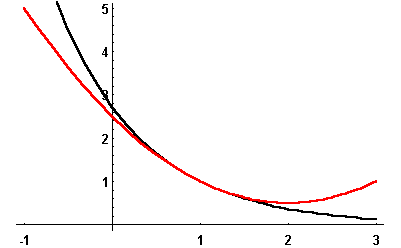 Taylor Polynomials
Taylor Polynomials
 Taylor Polynomials
Taylor Polynomials
The derivative of f(t) is  , thus
, thus  .
Since
.
Since  , we obtain as an equation for the tangent line at
, we obtain as an equation for the tangent line at ![]() :
:
![]()
One way to see that the tangent line to a function f(x) at
a given point ![]() is the best line approximating the function is to observe that the tangent line is the (only) line
passing through the point
is the best line approximating the function is to observe that the tangent line is the (only) line
passing through the point ![]() and having the same slope as f(x) at
and having the same slope as f(x) at ![]() .
.
So what about about finding the "best'' parabola approximating the function f(x) near ![]() ? We should look for the parabola passing through
? We should look for the parabola passing through ![]() , which has the same slope (the first derivative) as f(x) at
, which has the same slope (the first derivative) as f(x) at ![]() , and which has the same second derivative as f(x) at
, and which has the same second derivative as f(x) at ![]() !
!
Let's try it: Consider ![]() near
near ![]() .
The parabola we are trying to find has the generic form:
.
The parabola we are trying to find has the generic form:
![]()
Writing the parabola this way, it is easier to compute its derivatives at ![]() : p'(x)=b +2 c (x-1) and p''(x)=2 c. Substituting
: p'(x)=b +2 c (x-1) and p''(x)=2 c. Substituting ![]() we obtain:
we obtain:
![]()
Recall, we want to find the parabola which has the same derivatives at ![]() as f(x). This yields the conditions:
as f(x). This yields the conditions:

Now ![]() ;
; ![]() and
and ![]() .
Solving for the coefficients and substituting in the formula for p(x), we obtain
.
Solving for the coefficients and substituting in the formula for p(x), we obtain
![]()
The polynomial p(x) is called the second degree Taylor polynomial
of the function ![]() at the point
at the point ![]() .
.
The picture below shows f(x) in black and its second degree Taylor polynomial at ![]() in red.
in red.
 |
It is not hard to see what the general formula will look like: If we replace ![]() by a "general''
by a "general'' ![]() above, we obtain:
above, we obtain:
![]()
as the general form of the Taylor polynomial at ![]() ;
We need that
;
We need that

and consequently
![]()
![]() is called the center of the Taylor polynomial. Note: The center
is called the center of the Taylor polynomial. Note: The center ![]() is fixed, the variable name for the polynomial is x. Even if we consider the same function f(x),
different centers will usually yield different Taylor polynomials (just as a function usually has different tangent lines at various points!).
is fixed, the variable name for the polynomial is x. Even if we consider the same function f(x),
different centers will usually yield different Taylor polynomials (just as a function usually has different tangent lines at various points!).
Click here for the answer, or to continue.